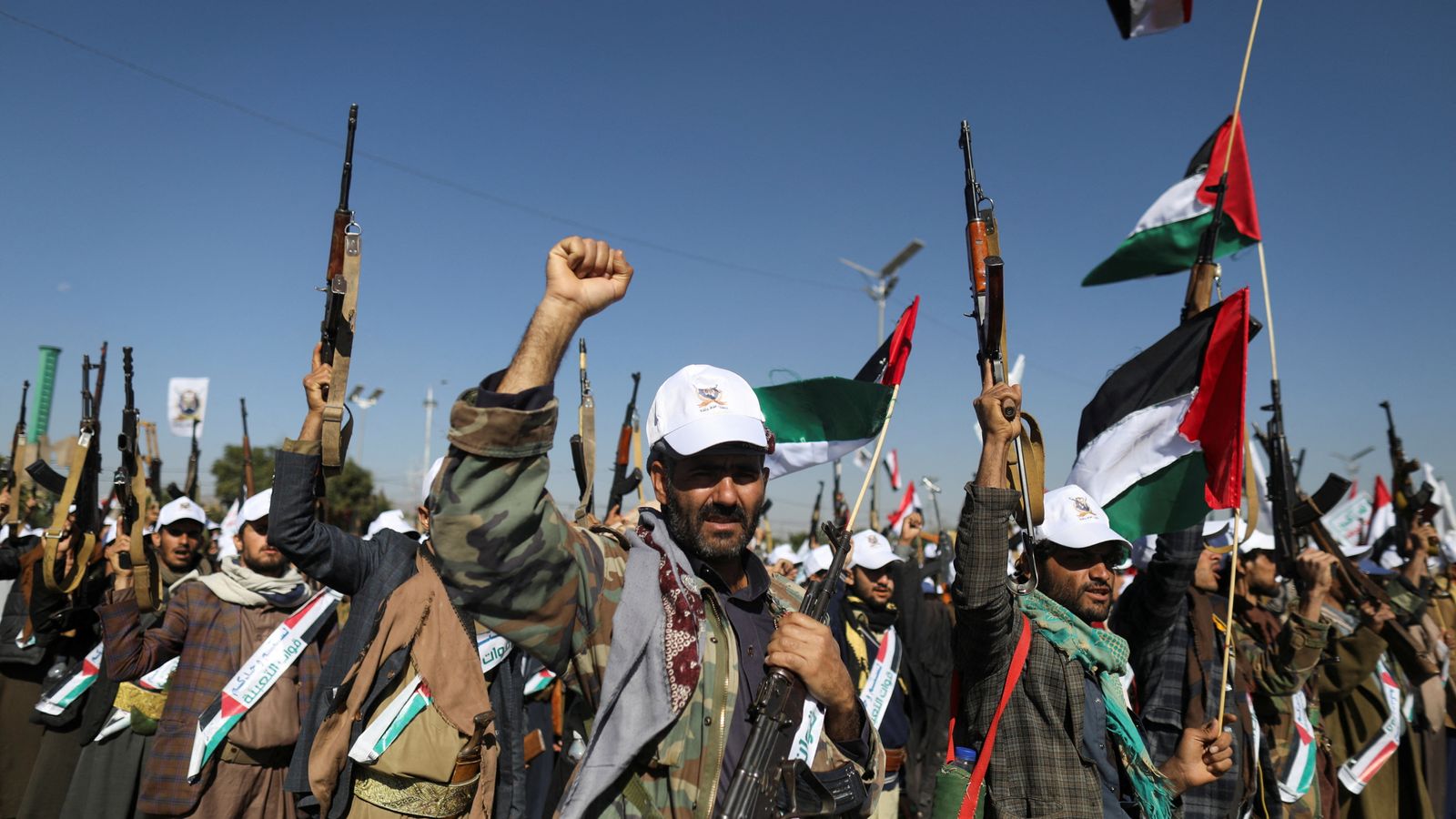Attacks by Yemen’s Houthi fighters – both on Israel and on commercial ships in the Red Sea – have led to British and US forces launching strikes in the area.
The Iranian-backed group had defied a warning to stop targeting ships in the Red Sea – and tensions escalated earlier this month after a British warship, in an operation with US forces, shot down seven drones launched by Houthis to repel the largest drone and missile attack to date.
That was the 26th Houthi attack on commercial shipping since 19 November, according to the US, when the group vowed to target vessels it believes are heading to and from Israel.
Middle East latest: Underground Houthi site hit in UK-US airstrikes
On Monday night, the US and UK carried out joint attacks on Houthi military targets in Yemen for a second time.
The strikes targeted a Houthi underground storage site and locations associated with the Houthis’ missile and air surveillance capabilities, a joint statement from the UK, US, Bahrain, Australia, Canada and the Netherlands said.
Who are the Houthis?
The Houthis – officially known as “Supporters of God” or “Ansar Allah” in Arabic – are a group of Shia Islamists based in western Yemen.
Formed in the 1990s, the group began as a movement to promote the rights of Zaidi Shias and the Houthi tribe, from which the group gets its name.
It opposes US and Israeli influence in the Middle East – with its slogan containing the words “death to America”, “death to Israel” and a “curse upon the Jews”.
Please use Chrome browser for a more accessible video player
Backed by Iran and allied with other Islamist groups in the region such as Hamas and Hezbollah, it has also accused Saudi Arabia of “colluding” with the US.
The death of the group’s founder, Hussein al Houthi, at the hands of the Yemeni military, sparked a civil war – the Houthi insurgency – in 2004.
Please use Chrome browser for a more accessible video player
The group, now led by his brother, Abdul-Malik al Houthi, also took part in the 2011 Yemeni revolution, gaining further territory.
Since then, it has furthered its area of influence and it now controls much of Yemen’s western seaboard down to the Bab al Mandeb Strait – the 16-mile stretch of water that marks the entrance to the Red Sea.
Why have they been attacking ships in the Red Sea?
The Houthis claim the attacks are aimed at ending the air and ground offensive on the Gaza Strip following the 7 October attacks by Hamas.
Several ships have been attacked with drones, rockets and in some cases helicopters have been used to drop militants on to commercial vessels.
In the first week of January, 18 one-way attack drones along with two anti-ship cruise missiles and one anti-ship ballistic missile were fired towards the British warship HMS Diamond and other commercial vessels.
It was dubbed by Grant Shapps, the defence secretary, as the “largest attack from the Iranian-backed Houthis in the Red Sea to date”.
A Houthi spokesperson claimed responsibility for the major missile and drone strike, claiming they had targeted a US warship that had been operating in support of Israel.
Click to subscribe to the Sky News Daily wherever you get your podcasts
Brigadier General Yahya Saree signalled the militants were not going to stop their mission, saying it would continue “until the aggression stops and the siege on our steadfast brothers in the Gaza Strip ends”.
The group also claimed responsibility for launching an attack on two ships – the Norwegian-owned Swan Atlantic and the Panama-flagged MSC Clara – using drones.
Please use Chrome browser for a more accessible video player
In November, militants from the group captured the cargo vessel, the Galaxy Leader.
Why have the UK and US launched strikes?
UK Defence Secretary Grant Shapps said the latest attacks ould “deal another blow” to the Houthis’ “limited stockpiles and ability to threaten global trade”.
In a statement issued shortly after the attacks started earlier in January US President Joe Biden said: “These targeted strikes are a clear message that the United States and our partners will not tolerate attacks on our personnel or allow hostile actors to imperil freedom of navigation in one of the world’s most critical commercial routes.”
Prime Minister Rishi Sunak also said Houthi attacks could not be allowed to stand.
He said: “The United Kingdom will always stand up for freedom of navigation and the free flow of trade. We have therefore taken limited, necessary and proportionate action in self-defence.”
How will disruption in the Red Sea impact me?
Concerns have been growing about the global economic impact of the disruption to shipping through the vital Red Sea, with vessels choosing to divert, pushing up the cost of trade and causing inflation to rise.
Around 12% of total global shipping traffic goes through the Suez Canal, which is the shortest route between Europe and Asia.
Primarily ships are carrying oil and liquefied natural gas from the Gulf, and consumer goods and electricals from China, Taiwan and Bangladesh.
Please use Chrome browser for a more accessible video player
The route is also key to food and drink supply chains, with tea and coffee being transported from east Africa, wine from Australia and New Zealand, processed frozen meat from Thailand, and rice from Cambodia.
Marco Forgione, director general at the Institute of Export and International Trade, told Sky News in December that oil prices had already gone up.
Be the first to get Breaking News
Install the Sky News app for free
He warned that ships delayed in the wrong place and causing congestion at ports had a knock-on effect in terms of price rises – meanwhile, product shortages will be felt in January, February and possibly beyond.
“Unfortunately there’s a significant risk of inflation increasing and costs going up for consumers – with things just escalating and getting worse,” he said.








